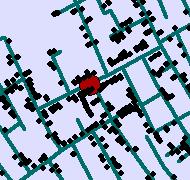2.5 GIS exploration of a point pattern
The purpose of this object is to consider a classic study in the history of epidemiology involving the investigation of a point-based disease dataset for which the causal mechanism was not understood at the time. Although conducted more than a century before the advent of GIS, the principles involved are of great relevance to our use of public health datasets in the GIS investigation of disease causality.
The presentation of this case is therefore a potential first step not only for medical cartographers but also for virtually all disciplines interested in the origin and diffusion of diseases
(Koch and Denike, 2004)

Broad Street cholera cluster map
In the Nineteenth Century London experienced a series of cholera epidemics. Cholera is an acute bacterial infection of the intestine caused by ingestion of food or water contaminated with the vibrio cholerae bacterium. Symptoms include diarrhoea and vomiting leading to severe dehydration which may be fatal (WHO, 2003). At the time, little was known of the causal mechanism of cholera and two principal rival theories were (a) miasmic theory: that the spread of cholera was through the air, polluted by decaying bodies and vegetation, and (b) polluted water theory: that it was through drinking water that had been polluted through some previous contact with the disease. John Snow was a physician who took a particular interest in the cholera epidemics and his observations led him to be a strong proponent of the polluted water theory. He noted that transmission rates were particularly high within poor households living in crowded insanitary accommodation with communal water sources. While mourners visiting the families of those who died in such homes would often themselves become infected, Snow noted that visiting physicians were rarely infected and that transmission rates were much lower where overcrowding was lower and sanitation better.

Modern replica of the water pump
He was convinced that a key difference was that family members and mourners would eat and drink in these homes and thus come in contact with the infection through contaminated food and drink, while physicians would not eat and would wash their hands after attending victims. A particular outbreak in the Golden Square area of London in 1854 caused Snow to concentrate his attention on the water supplies in that area, which were provided by public pumps in the streets. He observed a cluster of cholera cases around the pump in Broad Street and, convinced that water from the pump was a source of infection, persuaded the authorities to remove the pump handle. Cholera deaths in the vicinity rapidly declined. Subsequent analyses suggest that this particular outbreak was already in decline, but the removal of the pump handle probably prevented a reoccurrence and provided further confirmation of the water-borne theory. In his subsequent investigations, Snow identified a brewery and workhouse close to the Broad Street pump in which there were far fewer cases than might have been expected given the infection rates in the surrounding houses. His research led him to discover that these institutions had their own wells and the brewery employees and workhouse inhabitants did not use water from the affected well. His analysis is an early example of comparing observed with expected rates in order to understand the pattern of the epidemic. It also points to the important interaction of biological and socioeconomic processes in explaining observed patterns of ill health.
The story of Snow’s mapping and investigation of the Broad Street pump leads us to a very important issue surrounding the use of GIS in the analysis of health. The popular story is that Snow mapped the cholera deaths and by application of spatial analytical reasoning identified the Broad Street pump as the source of the epidemic. The reality is rather different, as we know that his approach was determined by his prior belief that the water supply was implicated in cholera causation. This aspect of the study is reviewed by Brody et al. (2000). Others examined the same evidence and still favoured the ultimately incorrect miasmic theory and it was not until around 25 years after Snow’s death that the vibrio cholerae bacterium was identified.
The exercise below demonstrates something of the difficulty of using raw mortality data to seek potential causal explanations in the absence of a theoretical framework. It serves to illustrate some ways in which spatial data analysis may assist in the investigation of theoretically informed causal models. Koch and Denike (2004) consider the GIS parallels with Snow’s analysis and reaffirm the relevance of this case study both to the practice of epidemiology and to GIS education!
Activity
Download the attached zip archive which contains ESRI data files for the Snow cholera data derived from Tobler (1994) and an instruction document in both ArcGIS Desktop and Pro formats.
References (Essential reading for this learning object indicated by *)
* Brody, H., Rip, M. R., Vinten-Johansen, P., Paneth, N. and Rachman, S. (2000) Map-making and myth-making in Broad Street: the London cholera epidemic 1854 The Lancet 356, 64-68 https://doi.org/10.1016/S0140-6736(00)02442-9
* Walford N (2020) Demographic and social context of deaths during the 1854 cholera outbreak in Soho, London: a reappraisal of Dr John Snow’s investigation Health & Place 65, 102402 https://doi.org/10.1016/j.healthplace.2020.102402
Note that a fully georeferenced version of the John Snow data set can be downloaded from here: http://blog.rtwilson.com/john-snows-famous-cholera-analysis-data-in-modern-gis-formats/ – see the practical activity below for further details.
The World Health Organisation (WHO) http://www.who.int/ website contains many entries on cholera (search for ‘cholera’), indicative of its enduring impact on health in many parts of the world affected by inadequate water supply.